Class 8 Exam > Class 8 Notes > English Poorvi Class 8 - New NCERT > NCERT Solutions: The Magic Brush of Dreams
The Magic Brush of Dreams NCERT Solutions | English Poorvi Class 8 - New NCERT PDF Download
Let us do these activities before we read (Page 122)
I. Work in pairs. Discuss the following questions. Share your answers with your classmates and teacher.1. Mention a magical object that you would like to have. Give a reason for your choice.
Ans: I would like to have a magical notebook that writes answers on its own. It would help me complete my homework quickly and learn better through smart suggestions.
2. What would you draw for yourself if you had a magic paintbrush? Why?
Ans: I would draw a flying bike to travel anywhere quickly and have fun exploring new places.
3. Would you use the magic paintbrush to draw for someone else? If yes, why? If not, why not?
Ans: Yes, I would use it to help poor people by drawing food, clothes, and houses for them. Everyone deserves to live happily.
II. Work in pairs. Discuss instances of acts of kindness that you have heard, read, or experienced. Share your answers with your classmates and teacher.
Ans: I once read about a boy who started a small food bank in his community to help hungry people. Another time, my friend gave his new shoes to a child in need. I also remember helping an injured bird and taking it to a vet. These acts of kindness make the world a better place.
III. Work in pairs and guess the meanings of the words given below and draw pictures depicting their meanings. Share with your classmates and teacher 
Meaning of the words
1. Paintbrush – A tool with bristles used to apply paint to a surface, often used in art or painting walls.
2. Joy – A strong feeling of happiness and pleasure.
3. Fortress – A large, strong building or place that is built to protect against attacks; like a castle.
4. Feast – A large and special meal, often made for celebrations.
5. Fear – A feeling of being scared or afraid of something.
6. Winding – Something that goes in curves or twists, like a winding road or path.
7. Twig – A small, thin branch from a tree or bush.
8. Bows – Ribbons tied into loops (like hair bows), or a curved weapon for shooting arrows, depending on context.
9. Drawing – A picture made with a pen, pencil, or crayon, usually on paper.
10. Cold – A low temperature that makes you feel chilly, or the opposite of warm.
Now, arrange these words into different categories as given below.
Things: .................................................................
Ans: Things: paintbrush, twig, fortress, bows, drawing
Actions: .................................................................
Ans: Actions: winding, feast
Emotions: .................................................................
Ans: Emotions: joy, fear, cold
Let us discuss (Page 127)
I. Arrange the events in order of occurrence in the poem. The last one has been marked for you. Share your answers with your classmates and teacher.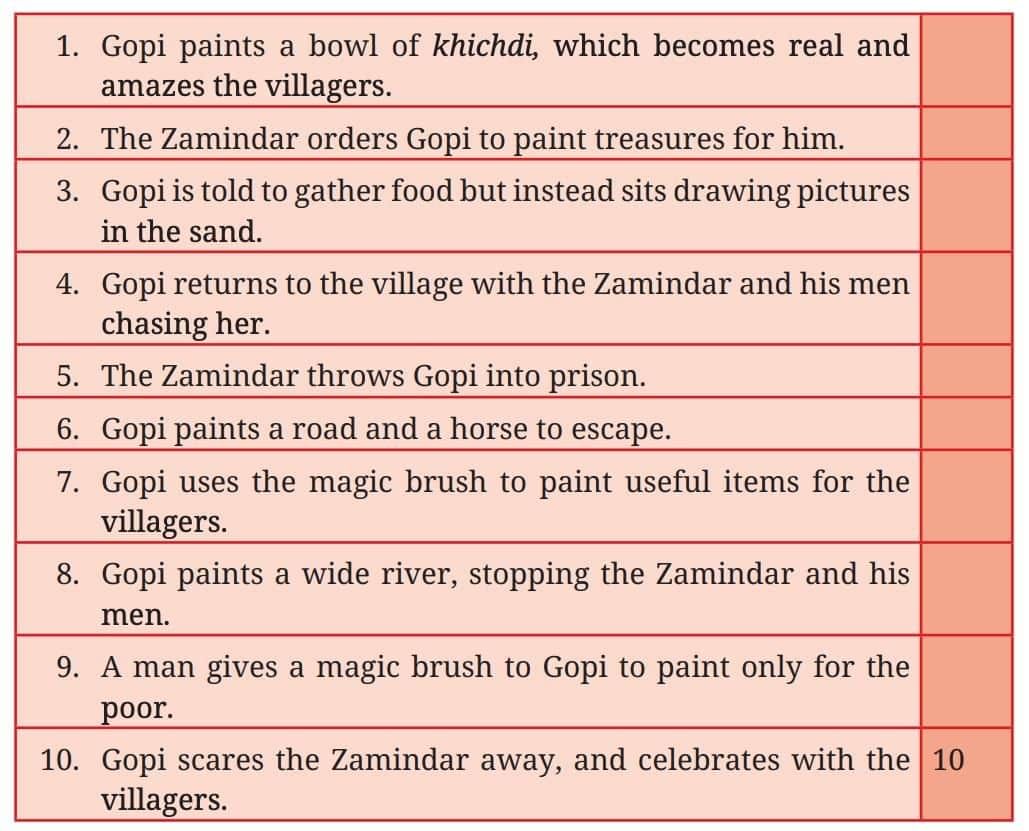 Ans:
Ans: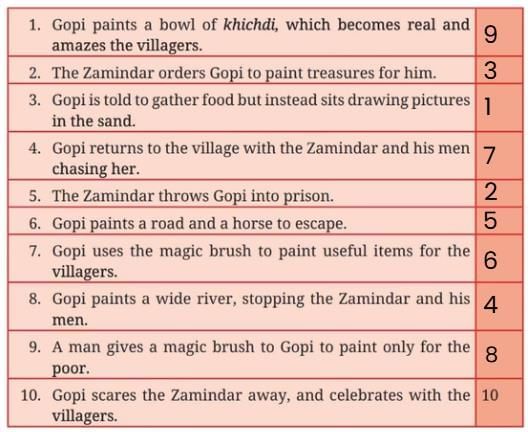
II. Fill in the blanks by choosing the correct answer from the box given below.
The tone of the poem shifts throughout, reflecting the different moods of the story. Initially, the tone is 1. _________________ as Gopi uses her imagination to draw in the sand, and later when the Zamindar enters the story, the tone shifts to one of 2. _________________. In the final part of the poem, the tone becomes 3. _________________ as Gopi escapes, theZamindar is defeated, and the villagers rejoice.
Ans: The tone of the poem shifts throughout, reflecting the different moods of the story. Initially, the tone is playful and innocent as Gopi uses her imagination to draw in the sand, and later when the Zamindar enters the story, the tone shifts to one of threatening and commanding. In the final part of the poem, the tone becomes triumphant as Gopi escapes, the Zamindar is defeated, and the villagers rejoice.
Ans: The tone of the poem shifts throughout, reflecting the different moods of the story. Initially, the tone is playful and innocent as Gopi uses her imagination to draw in the sand, and later when the Zamindar enters the story, the tone shifts to one of threatening and commanding. In the final part of the poem, the tone becomes triumphant as Gopi escapes, the Zamindar is defeated, and the villagers rejoice.
III. Fill in the blanks by choosing the correct option from within the brackets.
1. The poem mostly follows a simple rhyme scheme, _________________, which adds a rhythmic flow. (ABCB, ABBA, ABAB)
Ans: The poem mostly follows a simple rhyme scheme, which adds a rhythmic flow: ABCB (e.g., “hand/sand” and “Gopi/hush” rhyme in the first stanza).
2. This poem belongs to the _________________ poetry genre, which tells a story through verse. (descriptive, narrative or ballad, free style)
Ans: This poem belongs to the poetry genre, which tells a story through verse: narrative or ballad.
IV. Give examples from the poem for the following explanations.
1. The poem is rich in imagery, creating clear pictures in the reader’s mind. For example, ___________________.
Ans: The poem is rich in imagery, creating clear pictures in the reader’s mind. For example: “She paints a mighty river wide, Its currents fast and deep” (vividly describes a wide, rushing river).
2. What is the effect of repetition in the line—‘On you, and you and you!’?
Ans: The effect of repetition in the line “On you, and you and you!” is: It emphasises Gopi’s threat to the Zamindar and his men, making it sound serious and directed at each person.
V. Match the phrases from the poem in Column 1 with what they symbolise in Column 2.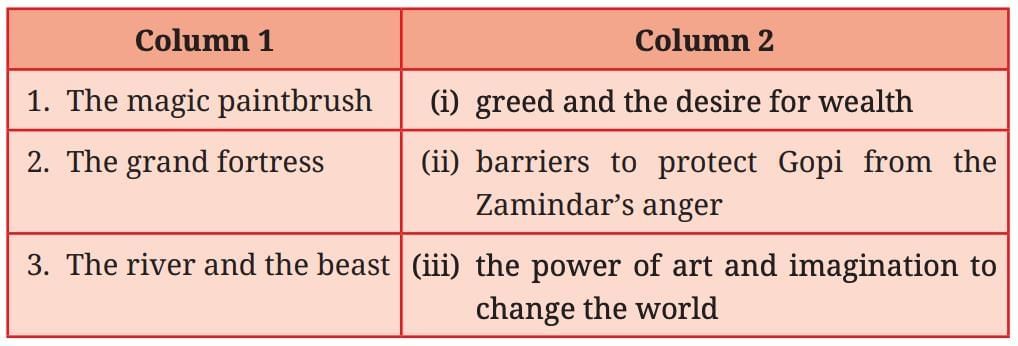 Ans:
Ans: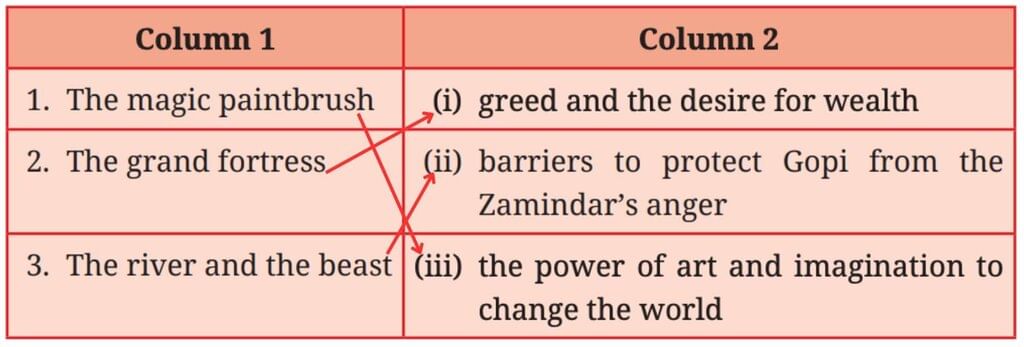
VI. Identify whether the following statement is true or false.
While Gopi uses the magic brush to help others, the Zamindar wants to use it for personal gain. This contrast drives the moral of the story.
Ans: True.
- Gopi uses the magic brush to help others, showing kindness and generosity.
- The Zamindar uses it for personal gain, showing greed.
- This difference highlights the moral of the story: selfless actions are good, and greed leads to harm.
Let us think and reflect (Page 128)
I. Read the given extracts and answer the questions that follow.
1. But on a stone there sits a man,
A brush is in his hand. He looks around.
He calls to Gopi. “Come here!” he whispers.
“Hush! We mustn’t let the village know
About this magic brush.”
He slips the brush into her hand
And tells her to be sure,
“Paint not for the wealthy ones,
But only for the poor.”
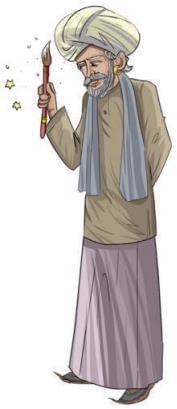
(i) Fill in the blank by selecting the correct option from those given in the brackets.
The man is whispering and telling Gopi to keep the brush a secret reflects his _______________________ (careful and secretive/ magical and delightful) nature.
Ans: careful and secretive
(ii) What is the significance of the man slipping the brush into Gopi’s hand?
Ans: It shows he trusts Gopi to use the magic brush responsibly for good purposes.
(iii) Complete the following sentence with a suitable reason.
The most likely reason the man instructs Gopi to ‘Paint not for wealthy ones but only for the poor’ is because he_______________________.
Ans: wants to help those who need it most, not those who are already rich.
(iv) Select the most appropriate title for the extract from the two given below.
A. The Magic Brush’s Secret
B. Gopi’s Special Gift
Ans: A. The Magic Brush’s Secret
because it focuses on the secrecy and the brush’s magic.
2. And soon the news spreads far and wide,
Through forests, fields, and plains,
Until the Zamindar himself
Hears of these magic gains.
“I order you to paint for me,
A fortress tall and grand.
Paint treasures, jewels, and riches rare,
Enough to rule this land.”
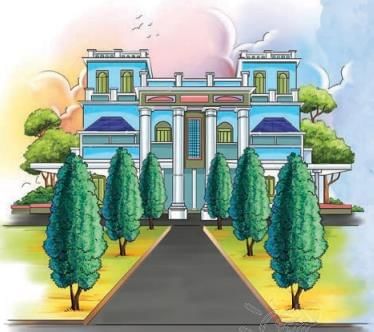
(i) Complete the following sentence with the correct reason.
The news of Gopi’s magic brush spreads ‘through forests, fields, and plains’ because of its _______________________.
Ans: amazing ability to create real objects from paintings
(ii) Why does the poet refer to things painted by Gopi’s paintbrush as ‘magic gains’?
Ans: The poet refers to things painted by Gopi’s paintbrush as “magic gains” because they become real, useful items that benefit the villagers.
(iii) Which of the following statements given below is false? Rectify the false statement.
A. Gopi’s magic brush draws the attention of the powerful Zamindar.
B. The Zamindar requests Gopi to paint a grand fortress and jewels.
Ans: B. The Zamindar requests Gopi to paint a grand fortress and jewels.
Rectified: The Zamindar orders Gopi to paint a grand fortress and jewels.
(iv) What does the Zamindar’s demand for a grand fortress and jewels reveal about his character?
Ans: The Zamindar’s demand for a grand fortress and jewels reveals about his character that he is greedy and wants power and wealth.
II. Answer the following questions.
1. Explain why Gopi made the right decision by refusing to paint for the Zamindar.
Ans: Gopi made the right decision because the Zamindar was greedy and wanted to misuse the brush for personal gain. Gopi remained loyal to her promise to use the brush only for the poor and needy.
Ans: Gopi made the right decision because the Zamindar was greedy and wanted to misuse the brush for personal gain. Gopi remained loyal to her promise to use the brush only for the poor and needy.
2. Gopi threatens to draw a beast to scare away the Zamindar. Justify her action. How would you have dealt with the situation differently?
Ans: Gopi’s action was justified because she was protecting herself and stopping the Zamindar from misusing the brush. She used her cleverness to scare him away without hurting anyone. If I were in her place, I might have done the same or tried to convince the villagers to stand up against the Zamindar together.
Ans: Gopi’s action was justified because she was protecting herself and stopping the Zamindar from misusing the brush. She used her cleverness to scare him away without hurting anyone. If I were in her place, I might have done the same or tried to convince the villagers to stand up against the Zamindar together.
3. What is the significance of Gopi celebrating with the villagers at the end of the poem?
Ans: It shows that goodness and kindness win in the end. It also highlights Gopi’s love for her village and her selfless use of the brush to bring happiness to others.
Ans: It shows that goodness and kindness win in the end. It also highlights Gopi’s love for her village and her selfless use of the brush to bring happiness to others.
4. Compare Gopi’s use of the magic brush to how the Zamindar would have used it.
Ans: Gopi used the brush to help the poor and bring joy, while the Zamindar wanted to use it to get wealth and power for himself. Gopi’s use was generous and kind, but the Zamindar’s use would have been greedy and harmful.
Ans: Gopi used the brush to help the poor and bring joy, while the Zamindar wanted to use it to get wealth and power for himself. Gopi’s use was generous and kind, but the Zamindar’s use would have been greedy and harmful.
5. What can be inferred about Gopi’s character based on her refusal to follow the Zamindar’s orders?
Ans: Gopi is brave, honest, kind, and determined. She values helping others over fear or pressure, and she stays true to her morals even when threatened.
Ans: Gopi is brave, honest, kind, and determined. She values helping others over fear or pressure, and she stays true to her morals even when threatened.
6. Justify the appropriateness of the title of the poem.
Ans: The title “The Magic Brush of Dreams” is appropriate because the brush fulfills the dreams of poor people by turning helpful drawings into real things. It brings hope and change through kindness and imagination.
Ans: The title “The Magic Brush of Dreams” is appropriate because the brush fulfills the dreams of poor people by turning helpful drawings into real things. It brings hope and change through kindness and imagination.
7. If you had the magic brush, how would you use it in today’s world?
Ans: I would use the brush to paint food for the hungry, homes for the homeless, medicines for the sick, and books for children without access to education. I would try to make the world a better place for those in need.
Let us learn (Page 130)
I. The verb ‘draw’ has different meanings in different contexts. Match the sentences in Column 1 with their appropriate meanings in Column 2.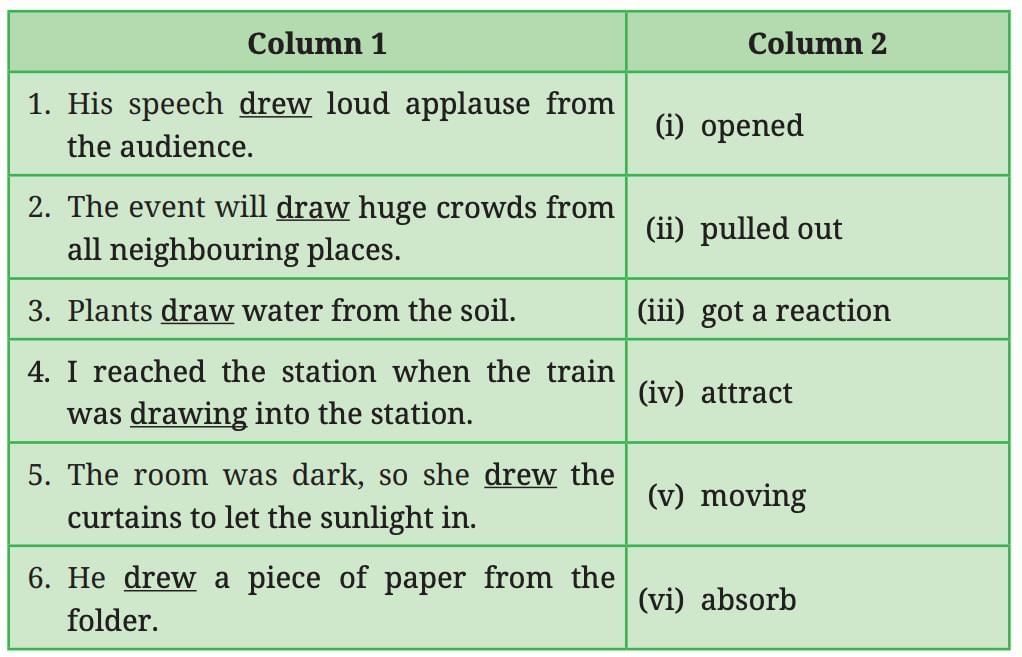 Ans:
Ans: 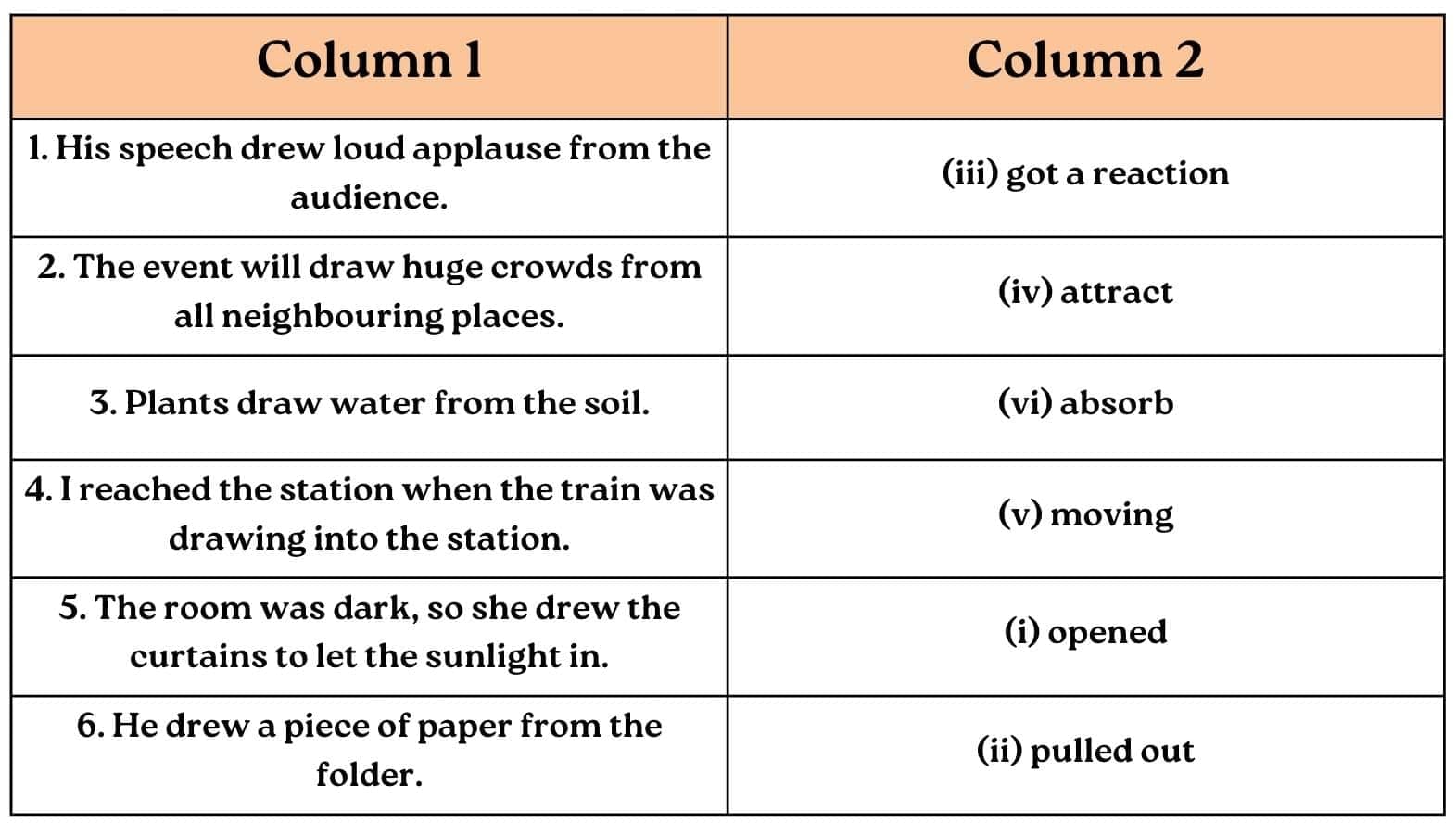
II. Fill in the crossword. Clues have been given below. You will find the words in the poem
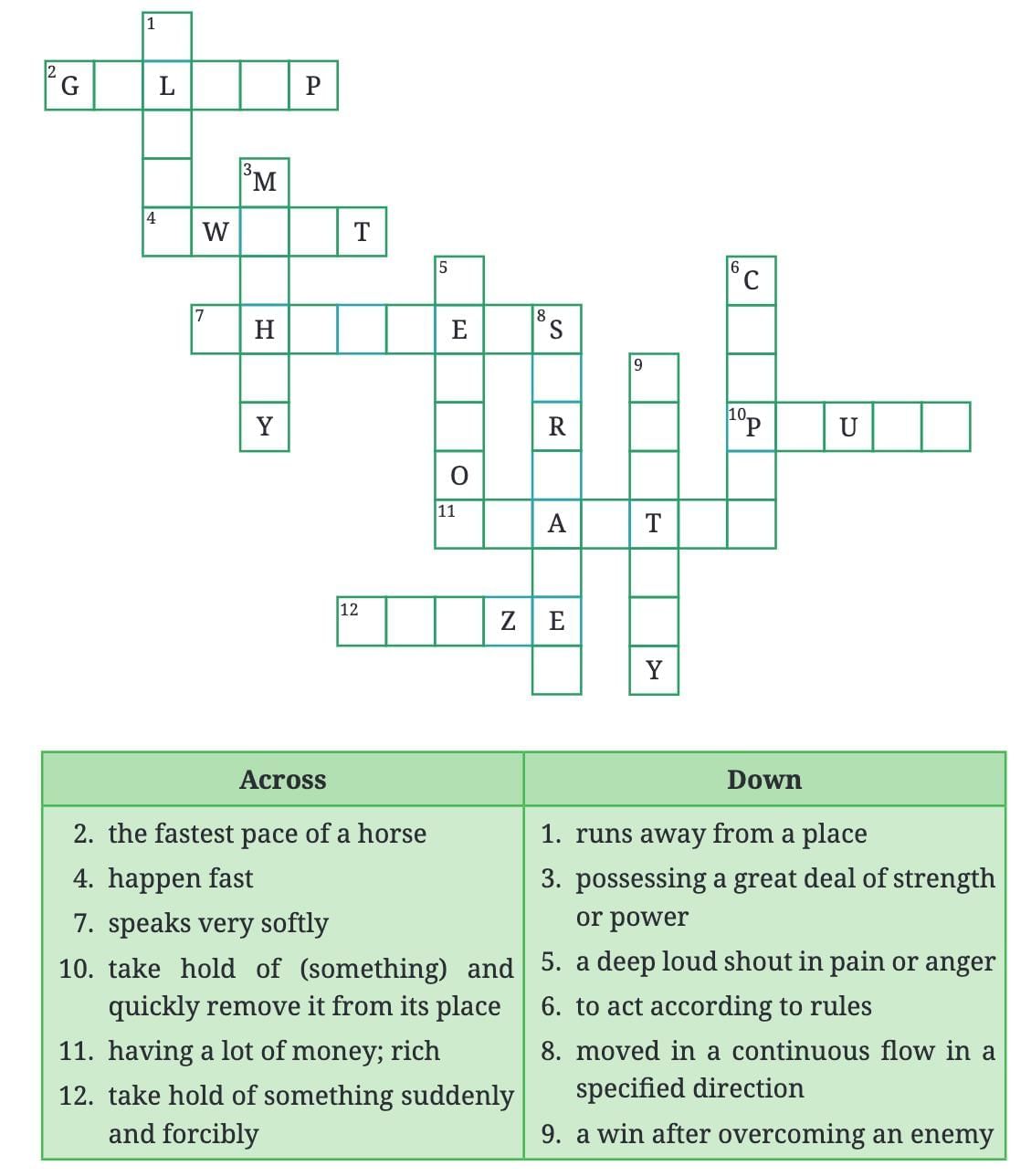 Ans:
Ans: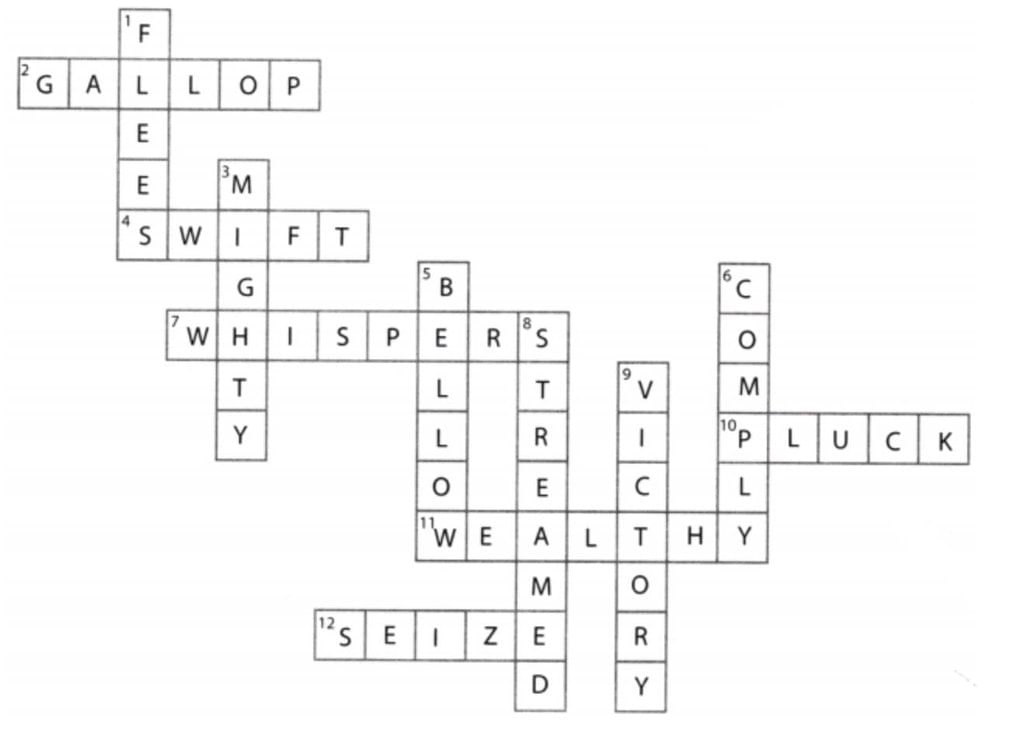
III. There are certain expressions that convey a sudden feeling or reaction. They can be used to express a variety of emotions and thoughts. Example: ... he whispers. “Hush!”
(‘Hush’ denotes the act of silencing someone)
Now, match the expressions in Column 1 with what emotions or reactions they convey, in Column 2.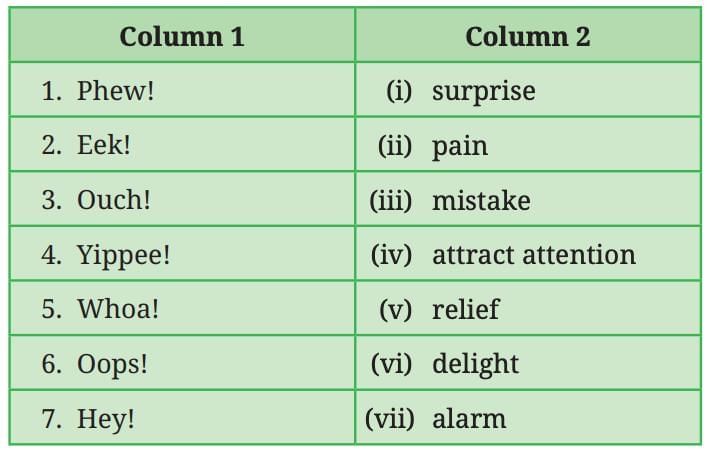 Now, create sentences using any five expressions from Column 1.
Now, create sentences using any five expressions from Column 1.
Ans: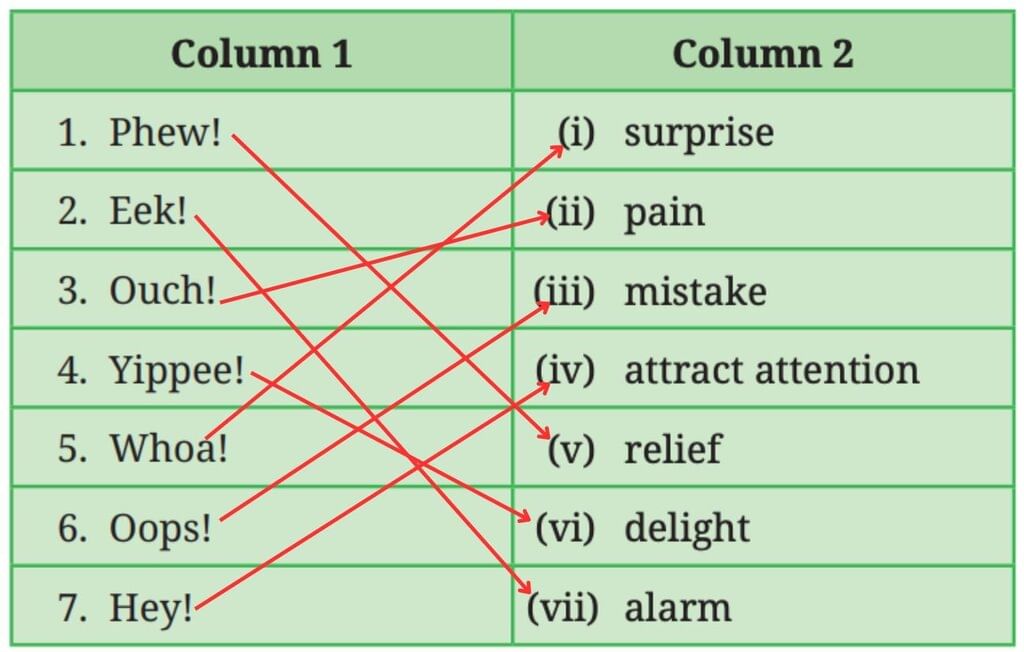
Let us listen (Page 132)
I. You will listen to five speakers speak about a magical power they wish for. As you listen, match statements 1–7 with speakers (i)–(v). There are two statements you do not need. 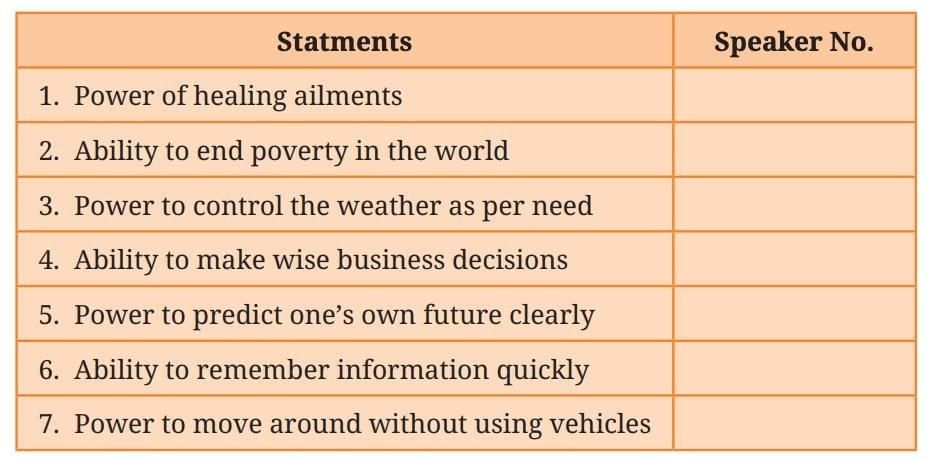
Speaker (i) : If I could have any magical power, I’d choose the ability to predict the future. Imagine being able to see profis and losses before time. I could make better savings and secure my business. Plus, I’d use it to help others make wise fiancial decisions as well.
Speaker (ii) : I think having the power to learn instantly would be amazing! Exams would be easy, and I’d have more time for activities I enjoy, like playing cricket. If I could remember everything, it would make life so much easier!
Speaker (iii) : I would want the power of fling. Imagine being able to see the world from up above clearly. I would be able to go from one place to another quickly without using any means of transport. It would be a dream come true.
Speaker (iv) : At my age, I’d love to have the power of healing. There are so many aches and pains that come with growing old, but it’s not just for me. If I could heal others too, I’d help my family stay healthy and happy.
Speaker (v) : If I had a magical power, I’d want control over the weather. We depend so much on the rains. With this power, I could ensure that crops always get the right amount of rain and sunshine.
Ans: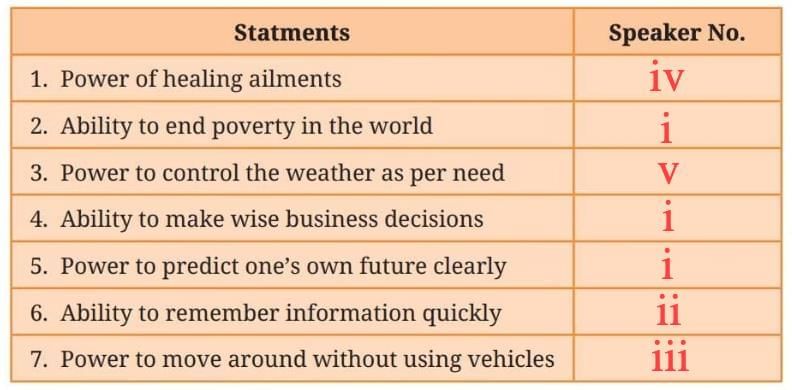
Let us speak (Page 133)
I. Intonation is the rise and fall of the pitch of tone while speaking.
The ‘falling’ tone is the fall in the pitch of the voice from a high level to a low level. It is marked [ ]. The falling tone is generally used in imperative sentences. Such sentences are used in speech for different communicative purposes— to express a command or an instruction, to ask for a favour or to give a warning.
Read the following sentences from the text with the falling tone.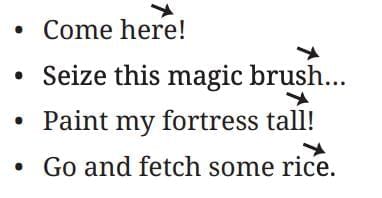 Ans: Practice reading with a falling tone (voice goes from high to low):
Ans: Practice reading with a falling tone (voice goes from high to low):
- Come here!
- Seize this magic brush.
- Paint my fortress tall.
- Go and fetch some rice.
II. Work in pairs. Take turns to make requests for the following formal and informal situations.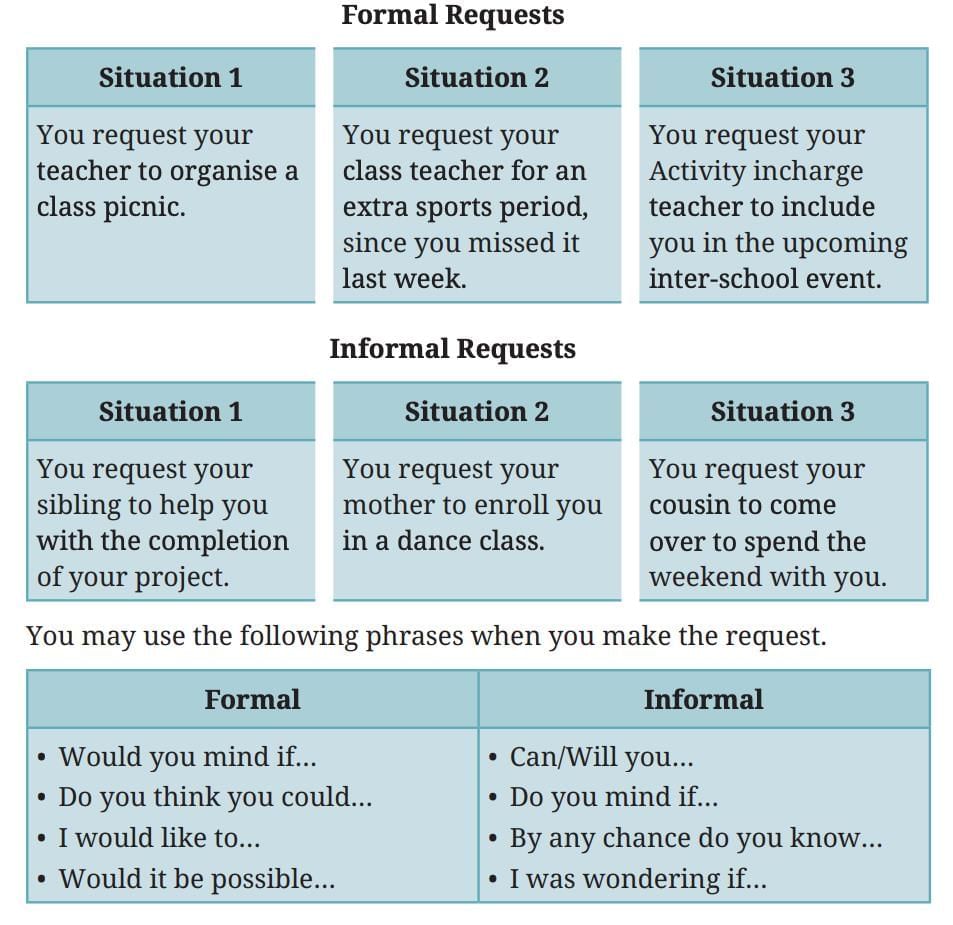 Ans:
Ans:
Formal Requests:
1. Would you mind if we had a class picnic, Ma’am?
2. Do you think you could add an extra sports period, since we missed it last week?
3. Would it be possible to include me in the inter-school event, Sir?
Informal Requests:
1. Can you help me with my project, please?
2. Mom, do you mind if I join a dance class?
3. Hey, can you come over this weekend?
Let us write (Page 134)
I. An Imaginative essay is a type of creative writing where the writers use their imagination. An imaginative essay can be based on real-life events, observation, or experiences. It is usually a descriptive piece or a personal reflection. Read the sample of an imaginative essay.
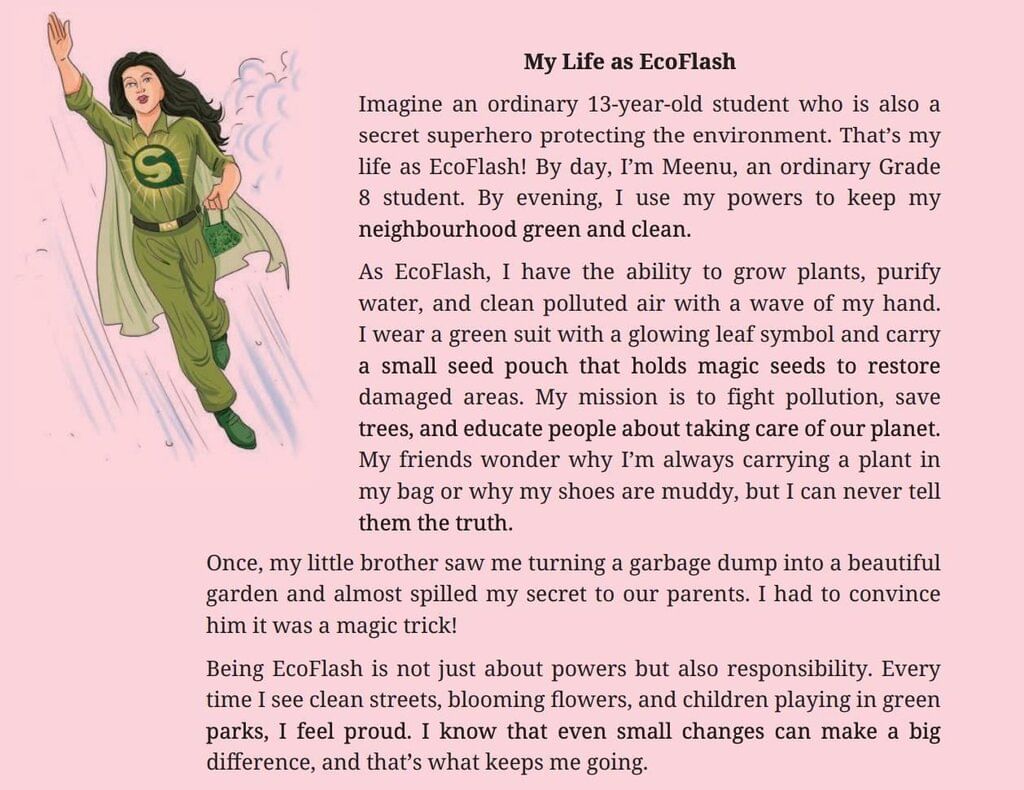
II. Complete the given checklist based on your observations and understanding of what an imaginative essay includes. Share the answers with your classmates and teacher.
Ans:
1. Title - A relevant title: Yes, “My Life as EcoFlash” is catchy and relevant.
2. Introduction
- Captivating opening sentence: Yes, introduces Meenu as a superhero.
- Clear statement of the setting, situation, or main idea: Yes, describes Meenu’s dual life.
- Establishes the tone: Yes, playful and adventurous.
- Introduces the narrator briefly: Yes, Meenu as EcoFlash.
3. Setting and Context
- Description of the setting: Yes, neighborhood and school.
- Clear time frame: Yes, present day.
- Brief explanation of imaginative elements: Yes, plant-growing powers.
4. Characters
- Main character introduced with unique traits: Yes, Meenu as EcoFlash.
- Supporting characters briefly described: Yes, brother and friends.
5. Central Idea
- Clear focus on a single powerful idea: Yes, protecting the environment.
- Logical flow of events: Yes, describes daily life and a key event.
6. Language and Style
- Use of sensory details: Yes, mentions muddy shoes and blooming flowers.
- Creative metaphors or similes: Yes, compares powers to a wave of the hand.
7. Resolution
- Key turning point or moment of realisation: Yes, brother almost reveals secret.
- Resolution of the main idea: Yes, continues mission.
- Clear takeaway message: Yes, small changes make a difference.
8. Conclusion
- Ends on a reflective note: Yes, feels proud of clean streets.
- Summarises the main message: Yes, emphasises environmental care.
III. Write an imaginative essay on any one of the following.
- Imagine you were a scarf that flew away from a clothesline. Describe the places you travelled to and how you came back. Also, write about what you thought was the most valuable experience.
- Imagine you stumbled upon a magical book in the library. The book transported you to a different period. Describe your experience and an important learning
Ans:
A Magical Book’s Adventure
One rainy afternoon, I found a dusty book in the school library titled “Time’s Door.” Its cover glowed faintly, and when I opened it, a light pulled me in! Suddenly, I was in ancient India, surrounded by bustling markets and colourful clothes. I saw merchants selling spices and heard musicians playing sitars. It was like a dream, but real!
I met a kind boy named Arjun, who showed me his village. We explored a grand palace with tall pillars and ate sweet jalebis. But I noticed people were sad because a drought had dried their fields. Using the book’s magic, I wrote a new page about rain clouds. Soon, gentle rain fell, and the villagers cheered as crops grew again.
Suddenly, the book glowed, pulling me back to the library. I was back in 2025, but the adventure taught me something important. Helping others, even in small ways, can bring happiness. I’ll never forget my journey through time and the lesson that kindness matters.
Let us explore (Page 136)
I. Have you heard of India’s famous magician, P. C. Sorcar Sr.? He is known as one of the ‘World’s Greatest Magician’ and performed live magic shows in front of audiences and on television, internationally.
He was awarded Padma Shri on 26 January 1964 for his contribution to the world of magic.
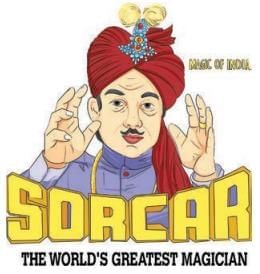 II. Words can also play tricks. Read the riddles about things that seem to be unreal and And what they refer to.
II. Words can also play tricks. Read the riddles about things that seem to be unreal and And what they refer to.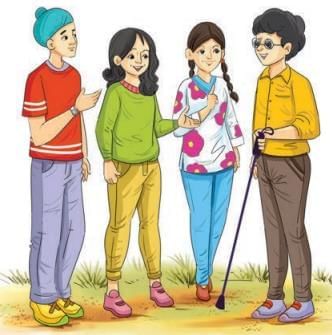
1. I can fill a room, but I take up no space. I’m often heard, but never seen. What am I?
Ans: Sound
2. The more you take, the more you leave behind. What am I?
Ans: Footsteps
3. I have cities but no houses,
I have forests but no trees.
What am I?
Ans: A map
4. I’m tall when I’m young and short when I’m old, in a dark room, my story is told.
Ans: A candle
III. You are asked to create a magical object. What object would you create? Make a drawing with all its details and mention its special quality on the same sheet. Put up the sheet on the display board.
Ans:
Object Name: Glow Sphere
Drawing Suggestion: A glowing crystal ball with stars and swirling mist inside.
Special Quality: It grants one wish a day—but only if the wish is kind and helps someone else. The GlowSphere glows brighter every time a good deed is done.
The document The Magic Brush of Dreams NCERT Solutions | English Poorvi Class 8 - New NCERT is a part of the Class 8 Course English Poorvi Class 8 - New NCERT.
All you need of Class 8 at this link: Class 8
|
59 videos|434 docs|57 tests
|
FAQs on The Magic Brush of Dreams NCERT Solutions - English Poorvi Class 8 - New NCERT
| 1. What is the central theme of "The Magic Brush of Dreams"? |  |
Ans. The central theme of "The Magic Brush of Dreams" revolves around the power of imagination and creativity. It emphasizes how dreams can inspire individuals to pursue their passions and create a better reality for themselves and others. Through the narrative, readers are encouraged to believe in their dreams and the transformative power of art and creativity.
| 2. How does the article suggest that listening plays a role in personal growth? |  |
Ans. The article suggests that listening is a vital component of personal growth because it allows individuals to learn from others' experiences and perspectives. By being open to the views of others, one can gain valuable insights, enhance understanding, and foster empathy, which ultimately contributes to personal development and self-awareness.
| 3. What activities are encouraged in the article as part of learning and reflection? |  |
Ans. The article encourages a variety of activities as part of learning and reflection, including self-assessment, engaging in discussions, and creative expression through writing and art. These activities are designed to help individuals internalize their experiences, think critically about them, and develop a deeper understanding of themselves and the world around them.
| 4. In what ways does the article highlight the importance of speaking out? |  |
Ans. The article highlights the importance of speaking out as a means of expressing one’s thoughts, ideas, and feelings. It stresses that effective communication is crucial for sharing one’s vision, advocating for oneself and others, and participating actively in societal discourse. Speaking out is portrayed as a way to influence positive change and inspire others.
| 5. How does the article connect the concepts of writing and creativity? |  |
Ans. The article connects writing and creativity by emphasizing that writing is a form of artistic expression that allows individuals to convey their thoughts and emotions. It portrays writing as a tool for exploring one’s imagination, reflecting on personal experiences, and communicating ideas. The act of writing is presented as a creative process that can lead to self-discovery and innovation.
Related Searches
















